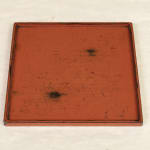-
Artworks
artisan's name unknown
Negoro nuri tray, late 1400s
wood, lacquer, plate
13 1/4” x 13 1/4” X 1/2”
Further images
During the Kamakura Period (1192 –1333), monks in the Negoro-Ji Temple began coating black common use utensils with red lacquer to distinguish them from ceremonial fixtures. This practice became popular,...
During the Kamakura Period (1192 –1333), monks in the Negoro-Ji Temple began coating black common use utensils with red lacquer to distinguish them from ceremonial fixtures. This practice became popular, and spread to many temples and shrines.
The red-lacquered utensils produced at Negoro-Ji came to be called Negoro-Nuri, (Negoro ware). After years of use, the red lacquer wore away and exposed its underlying black coating. This degradation revealed fine cracks that gave the surface a beautiful, weathered appearance. Artisans in the Edo period (1600 - 1863) realized the beauty of this effect. They began to artificially replicate the same result by sanding the red surface until patches of black lacquer appeared underneath, “crafting” erosion without the commitment of long-lasting use.
This tray was produced during the middle of the Muromachi era (1336-1573), before Edo craftsmen began to simulate Negoro style. Understanding its authenticity, we imagine the tray’s use within a temple in the 15th century. The black patterns on its surface could be the marks of a sake decanter and a sake cup. Every evening, a monk-in-training could have brought sake in a decanter and a cup on the tray to an "enlightened" monk. They had to be placed in the same way, every day. Used over a long period of time, the tray transformed into an exceptional art piece. Ritual use has imparted its mark into this tray, giving it quiet and powerful beauty.
This tray has a lower rim than many other trays of the same era. This gives it a lighter and more elegant look, and it is rare. It would have great charisma if placed on the wall as artwork.
The red-lacquered utensils produced at Negoro-Ji came to be called Negoro-Nuri, (Negoro ware). After years of use, the red lacquer wore away and exposed its underlying black coating. This degradation revealed fine cracks that gave the surface a beautiful, weathered appearance. Artisans in the Edo period (1600 - 1863) realized the beauty of this effect. They began to artificially replicate the same result by sanding the red surface until patches of black lacquer appeared underneath, “crafting” erosion without the commitment of long-lasting use.
This tray was produced during the middle of the Muromachi era (1336-1573), before Edo craftsmen began to simulate Negoro style. Understanding its authenticity, we imagine the tray’s use within a temple in the 15th century. The black patterns on its surface could be the marks of a sake decanter and a sake cup. Every evening, a monk-in-training could have brought sake in a decanter and a cup on the tray to an "enlightened" monk. They had to be placed in the same way, every day. Used over a long period of time, the tray transformed into an exceptional art piece. Ritual use has imparted its mark into this tray, giving it quiet and powerful beauty.
This tray has a lower rim than many other trays of the same era. This gives it a lighter and more elegant look, and it is rare. It would have great charisma if placed on the wall as artwork.









